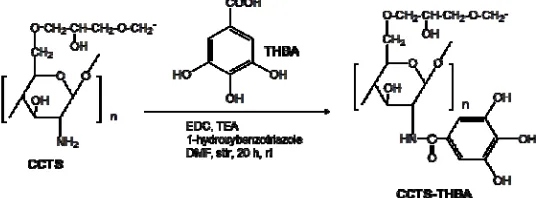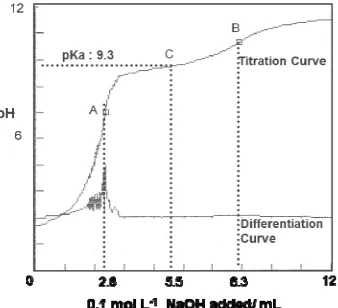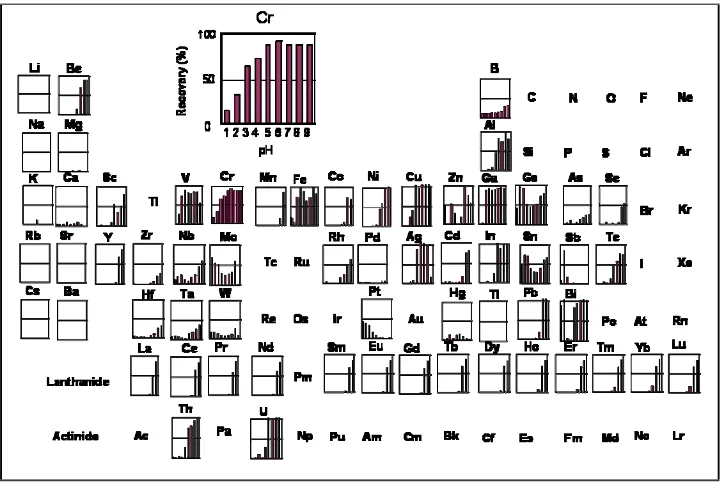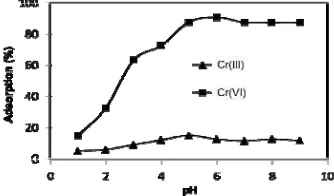The journal homepage www.jpacr.ub.ac.id ISSN : 2302 ‐ 4690
48
Functionalization of Chitosan with 3,4,5-Trihydroxy Benzoic Acid
Moiety for The Uptake of Chromium Species
Akhmad Sabarudin1*, and Shoji Motomizu2
1
Department of Chemistry, Faculty of Science, Brawijaya University, Jl Veteran Malang 65145, Indonesia 2
Department of Chemistry, Faculty of Science, Okayama University, Tsushimanaka 3-1-1, Okayama City 700-8530, Japan
*
Corresponding author: [email protected] ; [email protected] Phone: +62-341-575838/ Fax: +62-341-554403
Received 22 March 2013 (as a revised and reviewed manuscript); Accepted 27 March 2013; Published for 1 April 2013
ABSTRACT
Chitosan-based chelating resin, the cross-linked chitosan functionalized with 3,4,5-trihydroxy benzoic acid moiety (CCTS-THBA resin), was newly synthesized and its adsorption behavior toward appropriate elements was investigated. At pH 5-9, the CCTS-THBA resin showed quantitative adsorption (87-91%) for Cr (VI), while only < 15% for Cr (III). The addition of cyclohexanediamine tetraacetic acid (CyDTA) to the samples resulted in a considerably increase of the adsorption of both chromium species. In this condition, Cr (III) is chelated with CyDTA to form anionic complexes at pH 3-5, which was then completely adsorbed on the resin by ion exchange mechanism. Similarly, the adsorption of Cr (VI) reached almost 100% in pH range of 3-6. The adsorption capacity of
CCTS-THBA resin for Cr (VI) was 109 mg g-1.
Key word: Chitosan, Chromium Uptake, Chelating Resin, Adsorption, CyDTA
INTRODUCTION
The determination of toxic elements in environmental samples is continuously a challenge in analytical chemistry field due to waste generated by industrial activities, which can cause drawback effects to the human health as well as the environmental system. The toxicity levels of some metals depend on the oxidation states of the elements. Therefore, nowadays, chemical speciation is becoming important research topics in environmental sciences.
The extensive use of chromium (Cr) as alloy, or trivalent (Cr III) and hexavalent (Cr VI) salts in industrial process, such as metallurgy, tanning, pigments, electroplating and other industries, has contributed in the release of chromium to the surface of environmental water system 1,2. Chromium (III) is considered as an essential micronutrient in mammals and combines with various enzymes for the maintenance of glucose, lipid and protein metabolism 3,4. On the other hands, chromium (VI) is a toxic species, owing to its oxidizing potential and
The journal homepage www.jpacr.ub.ac.id ISSN : 2302 ‐ 4690
49
Cr (III) is mainly found in the form of cationic hydroxo complexes as Cr (H2O)4OH2+, Cr(OH)2+, Cr(OH)2+, etc., whereas Cr (VI) is frequently found as CrO42-, HCrO4-, or Cr2O72-, depending on the pH of the medium 4,8. Therefore, it is noteworthy to estimate the individual species of chromium in the environment samples.
The use of chelating resins as a solid phase extractant (SPE) have been receiving considerable attention due to its high separation efficiency accompanied with excellent enrichment factor, and capable of combination with different detection techniques. The chelate formation occurred in polymeric materials is favored due to the enhanced formation constant over the simple chelating agents resulting from the large area of polymer with chelating functionality9. Consequently, the functional chelating resins for adsorption/separation of metals including chromium have been developed so far. Mondal10 reported functionalization of polystyrene divinyl benzene with 2- naphthol-3,6-disulfonic acid through azo bond (-N=N-) formation. Two forms of chromium showed different exchange capacities at different pH values; Cr (III) could be retained on the resin at pH > 5, whereas Cr (VI) was retained at pH 1.5. However, the presence of Al (III), Fe (III), and V (IV) in the samples caused a decrease in adsorption affinity towards Cr (III). Similarly, the sorption of Cr (VI) on the resin decreased due to the interferences from V (V) as VO3-, and PO43-. Amberlite XAD-4 copolymer functionalized with maleic acid has excellent ability for the adsorption of Cr (III) at pH 4 – 5.5 with adsorption capacity of 7.52 mg g-1, whereas Cr (VI) could not be retained on the resin. The adsorption of Cr (III) was not adversely affected by the most metal ions including alkali and alkaline earth matrices, whereas the existence of Fe (III) in the sample seems to influence the adsorption efficiency of Cr (III) 11.
The use of biomass and its modification as solid phase extraction material has been becoming favorable because of its typical properties: availability, mechanical strength, high porosity, hydrophilicity and chemical reactivity in functionalizations. Crab shells can be used for the adsorption of Cr (VI) at pH 2.5. However, higher affinity of V (V) towards crab shells reduces the uptake of Cr (VI) significantly12. Biosorption of Cr (III) on Bacillus sphericus loaded Diaion SP-850 was studied by Tuzen et al 13. It was found that Cr (III) could be adsorbed at pH ≥ 5, whereas Cr (VI) was retained below 5%. The capacity of this biosorbent for Cr (III) was 6.95 mg g-1. Similarly, Funaria hygrometrica (moss) immobilized in a polysilicate matrix selectively adsorbed Cr (III) at pH 4-8 while Cr (VI) still remained in the solution. The sorption capacity of the immobilized moss was found to be 11.5 mg g-1 for Cr (III) 14. The adsorption and speciation of chromium by saltbush (Atriplex canescens) biomass was reported by Sawalha et al 15. Chromium (III) could be adsorbed quantitatively at pH 4, whereas less than 50% of Cr (VI) retained, though that speciation of chromium is difficult by using this biomass. Other biomass-based chelating resins, agarose modified with iminodiacetic acid quantitatively adsorbed Cr (III) at pH 3, whereas agarose-based anion exchanger (Q-Sepharose) accumulated only Cr (VI). By using these agarose-based chelating resins coupled with flame atomic absorption spectrometry (FAAS), speciation of Cr (III) and Cr (VI) were performed 16.
Chitosan provides superior chelating ability compared with other natural polymers (i.e. activated sludges) and synthetic polymer bases commercially available 17. Other considerable advantages of chitosan include non-hazardous material, easy derivatization of its amino groups, and fast in sorption kinetics of the interest species. Therefore, the use of chitosan as base material for the synthesis of chelating resin has becoming a great increase.
The journal homepage www.jpacr.ub.ac.id ISSN : 2302 ‐ 4690
50
ethyleneglycoldiglycidylether (EGDE) was chemically modified with functional moieties of 3,4,5-trihydroxy benzoic acid (CCTS-THBA resin). Then, the adsorption behavior of Cr species and other 60 elements was examined by using mini-column method and their concentrations were measured by inductively coupled plasma atomic emission spectrometry (ICP-AES).
EXPERIMENTAL
Apparatus
The measurement of chromium and other elements were conducted by An ICP-AES (Vista Pro, Varian). Functional group, which shows the existence of the resin, was identified with a FT/IR-4100 spectrometer, (JASCO Co., Japan). The pKa value of CCTS-THBA resin was estimated using the acid-base titration method by employing an automatic titration system, Model AT-510, (Kyoto Electronics Manufacturing Co., Japan). The resin was packed inside PTFE mini-column tubing (4 mm i.d. x 50 mm) and was connected to syringe pump (Cavro, USA) for examination of its adsorption behavior.
Reagents and materials
The functional moiety of 3,4,5-trihydroxy benzoic acid (THBA), and chitosan flake were purchased from Tokyo Kasei Co. Ltd (Japan). Other reagents used for the synthesis of CCTS-THBA resin was of analytical reagent grade. Analytical multielement standard solutions were prepared by the accurate dilution of a mixed stock solution containing 10 mg L-1 metal ions for ICP-MS, XSTC-13 and XSTC-1 (Spex CertiPrep, Metuchen, NJ, USA) and other single-element stock solutions (1000 mg L-1) for AAS. Total elements in mixing solution are 60 elements, such as Li, Na, K, Rb, Cs, Be, Mg, Ca, Sr, Ba, Sc, Y, Zr, Hf, La, V, Nb, Ta, Ce, Th, Cr, Mo, W, Pr, Mn, Nd, U, Fe, Co, Rh, Sm, Ni, Pd, Eu, Cu, Ag, Gd, Zn, Cd, Hg, Tb, B, Al, Ga, In, Tl, Dy, Ge, Sn, Pb, Ho, As, Sb, Bi, Er, Se, Te, Tm, Yb, and Lu. For the examination of adsorption behavior CCTS-THBA resin toward Cr (III) and Cr (VI), chromium nitrate nonahydrate (Kanto Chemicals, Japan) and sodium chromate tetrahydrate (Kanto Chemicals, Japan), was used respectively. Ultrapure grade nitric acid (60 %, density 1.38 g mL-1 Kanto Chemicals, Japan) was diluted with ultrapure water to give a 1 mol L-1 and a 2 mol L-1 acid solutions for column treatment. Acetic acid (minimum 96 %) and ammonia water (29 %) used for the preparation of ammonium acetate buffer solution were of an electronic industrial reagent grade (Mitsubishi Chemical, Japan). Trans-1,2-Diaminocyclohexane-N,N,N',N'-tetraacetic acid (CyDTA) as a complexing agent for Cr (III) was purchased from Dojindo, Japan.
The journal homepage www.jpacr.ub.ac.id ISSN : 2302 ‐ 4690
51
Synthesis of CCTS-THBA resin procedure
The synthesis of CCTS-THBA resin consist of two steps, such as (1) synthesis of cross-linked chitosan (CCTS) with the cross-linker of ethyleneglycoldiglycidylether (EGDE) as in our previous work18 and (2) chemically bonding of 3,4,5-trihydroxy benzoic acid (THBA) moiety to amino group of CCTS by the formation of amide bond as shown in Fig.1. In this procedure, 10 g of THBA, 16 g of 1-ethyl-3-(3-dimethylaminopropyl)-carbodiimide (EDC), 12 g of triethylamine (TEA) and 1 g of 1-hydroxybenzotriazole were mixed in 60 mL of dimethyl formamide (DMF). Then, 5 g of the CCTS was suspended in the solution followed by stirring the mixture for 20 hours at room temperature. The final product was filtered off using a glass filter and washed with methanol and water.
Mini-column pretreatment procedure
The CCTS-THBA resin was washed by stirring at low speed in 2 mol l-1 nitric acid for 6 h to remove such residual metal impurities during its synthesis. Then, each resin was packed in mini-column (2 mm i.d x 40 mm). In the first step, the column was conditioned by flowing 2.5 ml of ammonium acetate buffer (pH 3-9 ; pH 1 and 2 were adjusted by HNO3 solution) using a syringe pump at the flow rate of 40 μL s-1. In the second step, 5 ml of 5 μgL -1
sample solution containing 60 elements (pH 1-9) was passed through column at speed of 20
μL s-1. In the third step, the column was washed with 1 mL of water. In the last step, the collected elements were quantitatively eluted with 2.5 ml of 2 mol L-1 HNO3 and 2.5 mL of water at flow rate of 20 μL s-1. The eluates were collected in the plastic tubes, followed by measurement with ICP-AES. For studying the adsorption behavior of the resin toward Cr (III) and Cr (VI), single standard of each chromium solution was used.
RESULTS AND DISCUSSION
Characteristics of CCTS-THBA resin
The IR spectrum of CCTS-THBA resin, in comparison with the cross-linked chitosan (CCTS), depicted additional band at 1758.76 cm-1, which is attributed to C=O of an amide bond formation. This additional band ensures the existence of THBA moiety attached to CCTS.
Figure 2. Acid-base titration of
The journal homepage www.jpacr.ub.ac.id ISSN : 2302 ‐ 4690
52
The acid base titration curve of CCTS-THBA resin was shown in Fig. 2. There are two pKa values that can be expected from the structure of the resin. The first pKa is attributed to 3- and 5- positions of hydroxyl groups of THBA moiety, whereas the second pKa come from the hydroxyl group in 4 position of the moiety. However, from the titration curve, only one pKa of 9.3 was clearly observed. The pKa values of 1,2-dihydroxy benzene, which are attributed to its hydroxyl groups, are 9.34 and 12.60. Therefore, the pKa of 9.3 observed in this resin, probably is due to the hydroxyl group at 4-position of THBA moiety. The pKa at 3- and 5- positions of the hydroxyl groups of the moiety could not be detected, since these pKa are expected very high, and cannot be detected by potentiometric titration method. The first end point (A) is due to neutralization of 0.1 mol L-1 HCl added to the solution in the initial step of titration. About 2.8 ml of 0.1 mol L-1 NaOH was required to neutralize HCl. In the second end point (B), 5.5 ml of 0.1 mol L-1 NaOH was required for neutralization of protonated hydroxyl group at 4-position of THBA moiety. From the result of titration, about
0.55 mmol of THBA moiety may exist in 1 ml of CCTS-THBA resin (1 mL ≈ 0.22 g dry weight). Therefore, the amounts of THBA moiety attached to cross-linked chitosan can be estimated about 2.5 mmol g-1 resin.
The adsorption capacity of the resin for Cr (VI) was examined by equilibrating 0.1 g of the CCTS-THBA resin with 100 mL of 150 mg L-1 Cr (VI) at pH 6. At appropriate interval time, 0.1 ml of the solution was taken and subsequently diluted to 100-fold with 1 mol L-1 HNO3 before measurement by ICP-AES. It was found that the adsorption capacity of CCTS-THBA resin for Cr (VI) was 109 mg g-1 resin.
Figure 3. Adsorption behavior of trace elements at various pHs with CCTS-THBA
The journal homepage www.jpacr.ub.ac.id ISSN : 2302 ‐ 4690
53
Adsorption behavior of CCTS-THBA resin
Figure 3 shows the results obtained for the adsorption behavior of 5 μg L-1 of mixed solution containing 61 elements from pH 1 to 9 onto the CCTS-THBA resin. The elements adsorbed on the resin were quantitatively recovered with 2 mol L-1 nitric acid as an eluent. The CCTS-THBA resin can adsorb various kinds of elements, such as Fe, V, Cr, Cu, Al, Ga, Ge, In, Ag, Bi, and U almost completely at pH > 5. However, the CCTS itself can adsorb Fe, V, Cu, Al, Ga, In, and Ag (Oshita et al., 2001). Therefore, the THBA moiety attached to CCTS seems to be good adsorption affinity towards Bi, Cr, Ge, and U at certain pH. Since the resin possesses strong affinity toward chromium, it is interesting to investigate which chromium species quantitatively adsorbed on the resin as discussed in the next section.
Figure 4. Adsorption behavior of Cr (III)
and Cr (VI) on CCTS-THBA resin in the absence of CyDTA (Sample: 5 μg L-1 of each chromium species).
Figure 5. Adsorption behavior of Cr (III)
and Cr (VI) on CCTS-THBA resin in the presence of CyDTA (Sample: 5 μg L-1 of each chromium species containing 6.5 x 10 -4
mol L-1 CyDTA).
Speciation of Cr (III) and Cr (VI)Using CCTS-THBA Resin
The journal homepage www.jpacr.ub.ac.id ISSN : 2302 ‐ 4690
54
Cr (VI) on the CCTS-THBA resin was about 91%, whereas its adsorption reached almost 100% when CyDTA and H2O2 were added to Cr (VI) solution. Without addition of CyDTA or H2O2, the partly conversion of Cr(VI) into Cr(III) is occurred in the sample. Moreover, since less than 15% of Cr (III) could be adsorbed on the resin at similar pH as Cr (VI), it is possible to perform the speciation of Cr (III) and Cr (VI) by using CCTS-THBA resin.
CONCLUSIONS
Good adsorption (87-91%) for Cr (VI) could be achieved by CCTS-THBA resin at pH 5-9 while slightly amount of Cr (III) was retained at similar condition. Completely adsorption (100%) cannot be achieved because of the partly conversion of Cr(VI) into Cr(III). However, in the presence of CyDTA in the samples, both chromium species were completely collected on the resin. Such results imply the applicability of this resin for chromium speciation.
REFERENCES
1. Djane, N. K., Ndung`u, K., Johnsson, K., Sartz, H., Tornstrom, T., Mathiasson, L., Talanta, 1999, 48, 1121 - 1132.
2. Saha, B., Gill, R. J., Bailey, D. G., Kabay, N., Arda, M., React. Funct. Polym., 2004, 60: 223-244.
3. Tunçeli, A., Türker, A. R., Talanta, 2000, 57, 1199-1204
4. Gómez, V., Callao, M. P., Trends Anal. Chem., 2006, 25, 1006-1015.
5. Cordero, M. T. S., Alonso, E. I. V., García de Torres, A., Pavón, J. M. C., J. Anal. At. Spectrom., 2004, 19: 398 - 403.
6. Garcia, E. A., Gomis, D. B., Analyst, 1997, 122: 899-902.
7. Motomizu, S., Jitmanee, K., Oshima, M., Anal. Chim. Acta, 2003, 499: 149-155.
8. Nakayama, E., Kuwamoto, T., Tsurubo, S., Tokoro, H., Fujinaga, T., Anal. Chim. Acta,
1981, 130, 289 - 294.
9. Amin, A. S., Chem. Pap., 2009, 63, 625-634.
10. Mondal, B. M., Das, D., Das, A. K., Talanta, 2002, 56, 145-152. 11. Yalçin, S., Apak, R. Anal. Chim. Acta, 2004, 505: 25-35. 12. Niu, H., Volesky, B., Hydrometallurgy, 2006, 84: 28-36.
13. Tuzen, M., Uluozlu, O. D., Soylak, M., J. Hazard. Mater., 2007, 144: 549-555.
14. Krishna, M. V. B., Chandrasekaran, K., Rao, S. V., Karunasagar, D., Arunachalam, J., Talanta, 2005, 65, 135-143.
15. Sawalha, M. F., Torresdey, J. L. G., Parsons, J. G., Saupe, G., & Videa, J. R. P. Microchem. J., 2005, 81: 122-132.
16. Hashemi, P., Boroumand, J., Fat`hi, M. R., Talanta, 2004, 64, 578-583.
17. Varma, A. J., Deshpande, S. V., Kennedy, J. F., Carbohydr. Polym., 2004, 55: 77-93. 18. Sabarudin, A., Oshita, K., Oshima, M., Motomizu, S., Talanta, 2005, 66: 136-144. 19. Oshita, K., Gao, Y. H., Oshima, M., and Motomizu, S., Anal. Sci., 2001, 17



